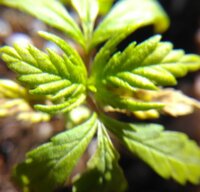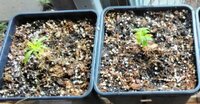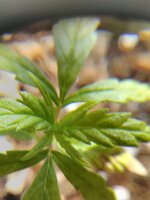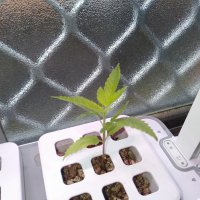Captain goodvibes
Well-Known Member
First, my setup. I use lights and fabric pots I sourced of Ebay. I have 2 grow chambers .6 x .8 metres side by side with a shared ventilation system. 8 inch exhaust fan sourced from Ebay.
Do not buy a cheap fan with a metal casing, they run too hot and may overheat your grow space.
Lights are 1 LED 240 watt quantum board colour temp 3600 for veg. 1 CMH 315 Watt 3000 colour temp for flowering. Having now been convinced of the efficacy of the LED quantum boards I will be replacing the CMH with another LED Quantum very soon, more than likely with a 480 watt. These Quantums are terrific, they can be dialled up or down with the dimmer, run very quiet and little heat.
Now, fabric pots. I learnt about these from this forum which I am grateful for, I also grow vegetables and fruit trees and fabric pots just beat everything no matter what you are growing. Use them.
What you need from Bunnings.
1. Coco, do not buy the added fertiliser variety, careful, they look very similar and you will need to read the labels carefully.
2. PH testing kit, PH up or down (depending on your PH tap water). My own tap water is very alkiline so I only need PH down.
3. eco flo dolomite- (cal Mag supplement)
4. Nitrosol.(for veg)
5. Power feed (for flower, red or pink bottle, both have similar nute profiles)
6. Small piece of shadecloth.
Important for coco, always, always ,PH balance your water, you want it around the 6 range.
Now, wash your coco throroughly through the shadecloth, rinse water through it till it runs clear, may take a while. Very important to do this as coco has a naturally high salt content. You are also getting rid of the fine particles in the coco which are detrimental.
Take a teaspoon of your cal mag supplement, mix it with Ph balanced water and soak the coco with it in a bucket for 24 hours. This will buffer the coco and avoid cal mag deficency through your grow.
You will need to have your plants sitting on something which can drain through, I have mine sitting on a metal grille I bought from Bunnings and they drain through to buckets underneath.
Whichever way you have germinated your seedlings ( I use the paper towel method) then plant tail down in the coco a couple of mm below the surface.
At this stage I just use a spray bottle with PH balanced water to keep the top of the coco moist.
Your seedling should pop its head up within a couple of days and show you their first set of leaves. Do not fertilise at this stage, furthermore do not over water, coco will retain water for an extensive time. What we want here is for the plant within the first few weeks to make a good root system, while many people say you cant over water coco from my experience that applies to mature plants not seedlings. Over watering early seedlings in coco will stunt them, every couple of days with water only is generally enough for seedlings, gradually increase the watering frquency as the plant gets older working your way up to 3 or 4 times a day when
flowering, always water till it drains through.
Commence nutrient watering about 4 or 5 days after the seedlings pop their heads up, 5 ml of Nitrosol to 4 litres of water every couple of days.
After around 2 weeks I increase this to 10 Ml to 4 litres of water and gradually increase to 20 ml up to when I flip.
After I flip them I add powerfeed but subtract Nitrosol, so I will start the flowering with 15 ml of Nitrosol to 5 Ml of powerfeed in 4 litres ph balanced water.
Over the next few weeks I gradually decrease the nitrosol and increase the powerfeed till near the end of the flowering I am only using a Powerfeed nute mix.
Your plant will probably love it at this time if you bump up the mix to 25 or 30 ml to 4 litres.
So the basics of this regime are that the plant wants lots of nitrogen for vegging and lots of phosphorous and potassium for flowering but is quite sensitive to to over fertilising.
.Just like most vegetables like tomatoes. if I wanted to grow great tomatoes I would and have followed the same plan. All this is from experience. The other thing is, look at your plants as much as you can and observe, you will get a feel of when they are suffering and will know what not to do.
Nitrosol and Powerfeed are also made from natural ingredients like organic blood and bone, fish meal, seaweed etc. You cant beat this trace element profile with any artifically created hydro nutes. The secret is in learning how to use these natural fertilisers as hydro nutes. And I can tell you they work just fine indoors and outdoors. I grew outdoors in soil (not pots, in the ground) for years using these same nutrients.
Hope all this makes sense. Feel free to message me about this.
Do not buy a cheap fan with a metal casing, they run too hot and may overheat your grow space.
Lights are 1 LED 240 watt quantum board colour temp 3600 for veg. 1 CMH 315 Watt 3000 colour temp for flowering. Having now been convinced of the efficacy of the LED quantum boards I will be replacing the CMH with another LED Quantum very soon, more than likely with a 480 watt. These Quantums are terrific, they can be dialled up or down with the dimmer, run very quiet and little heat.
Now, fabric pots. I learnt about these from this forum which I am grateful for, I also grow vegetables and fruit trees and fabric pots just beat everything no matter what you are growing. Use them.
What you need from Bunnings.
1. Coco, do not buy the added fertiliser variety, careful, they look very similar and you will need to read the labels carefully.
2. PH testing kit, PH up or down (depending on your PH tap water). My own tap water is very alkiline so I only need PH down.
3. eco flo dolomite- (cal Mag supplement)
4. Nitrosol.(for veg)
5. Power feed (for flower, red or pink bottle, both have similar nute profiles)
6. Small piece of shadecloth.
Important for coco, always, always ,PH balance your water, you want it around the 6 range.
Now, wash your coco throroughly through the shadecloth, rinse water through it till it runs clear, may take a while. Very important to do this as coco has a naturally high salt content. You are also getting rid of the fine particles in the coco which are detrimental.
Take a teaspoon of your cal mag supplement, mix it with Ph balanced water and soak the coco with it in a bucket for 24 hours. This will buffer the coco and avoid cal mag deficency through your grow.
You will need to have your plants sitting on something which can drain through, I have mine sitting on a metal grille I bought from Bunnings and they drain through to buckets underneath.
Whichever way you have germinated your seedlings ( I use the paper towel method) then plant tail down in the coco a couple of mm below the surface.
At this stage I just use a spray bottle with PH balanced water to keep the top of the coco moist.
Your seedling should pop its head up within a couple of days and show you their first set of leaves. Do not fertilise at this stage, furthermore do not over water, coco will retain water for an extensive time. What we want here is for the plant within the first few weeks to make a good root system, while many people say you cant over water coco from my experience that applies to mature plants not seedlings. Over watering early seedlings in coco will stunt them, every couple of days with water only is generally enough for seedlings, gradually increase the watering frquency as the plant gets older working your way up to 3 or 4 times a day when
flowering, always water till it drains through.
Commence nutrient watering about 4 or 5 days after the seedlings pop their heads up, 5 ml of Nitrosol to 4 litres of water every couple of days.
After around 2 weeks I increase this to 10 Ml to 4 litres of water and gradually increase to 20 ml up to when I flip.
After I flip them I add powerfeed but subtract Nitrosol, so I will start the flowering with 15 ml of Nitrosol to 5 Ml of powerfeed in 4 litres ph balanced water.
Over the next few weeks I gradually decrease the nitrosol and increase the powerfeed till near the end of the flowering I am only using a Powerfeed nute mix.
Your plant will probably love it at this time if you bump up the mix to 25 or 30 ml to 4 litres.
So the basics of this regime are that the plant wants lots of nitrogen for vegging and lots of phosphorous and potassium for flowering but is quite sensitive to to over fertilising.
.Just like most vegetables like tomatoes. if I wanted to grow great tomatoes I would and have followed the same plan. All this is from experience. The other thing is, look at your plants as much as you can and observe, you will get a feel of when they are suffering and will know what not to do.
Nitrosol and Powerfeed are also made from natural ingredients like organic blood and bone, fish meal, seaweed etc. You cant beat this trace element profile with any artifically created hydro nutes. The secret is in learning how to use these natural fertilisers as hydro nutes. And I can tell you they work just fine indoors and outdoors. I grew outdoors in soil (not pots, in the ground) for years using these same nutrients.
Hope all this makes sense. Feel free to message me about this.









